This 7 day Croatia itinerary spares no detail so you can create your perfect trip to this part of the Mediterranean.
Croatia was a destination that had long been on my bucket list. World famous for its turquoise waters and historic old cities, it’s one of those places that looks too beautiful to be true!
And remarkably, The nation’s beauty isn’t limited to its eye-catching stretch of the Adriatic coast. Croatia is also home to striking mountains, cascading waterfalls, and ancient Roman ruins that have stood the test of time. So it’s no wonder the region caught the eyes of the makers of Game of Thrones, a legacy you can feel in every corner of Split and Dubrovnik.
Before you jet-set off, this guide shares the need-to-know deets to help you shape your one-week Croatia itinerary to your liking.
This post may contain affiliate links, meaning at no additional cost to you, if you click my links and make a purchase, I may earn a small commission. Learn more on my disclosure page. Thank you for your support!
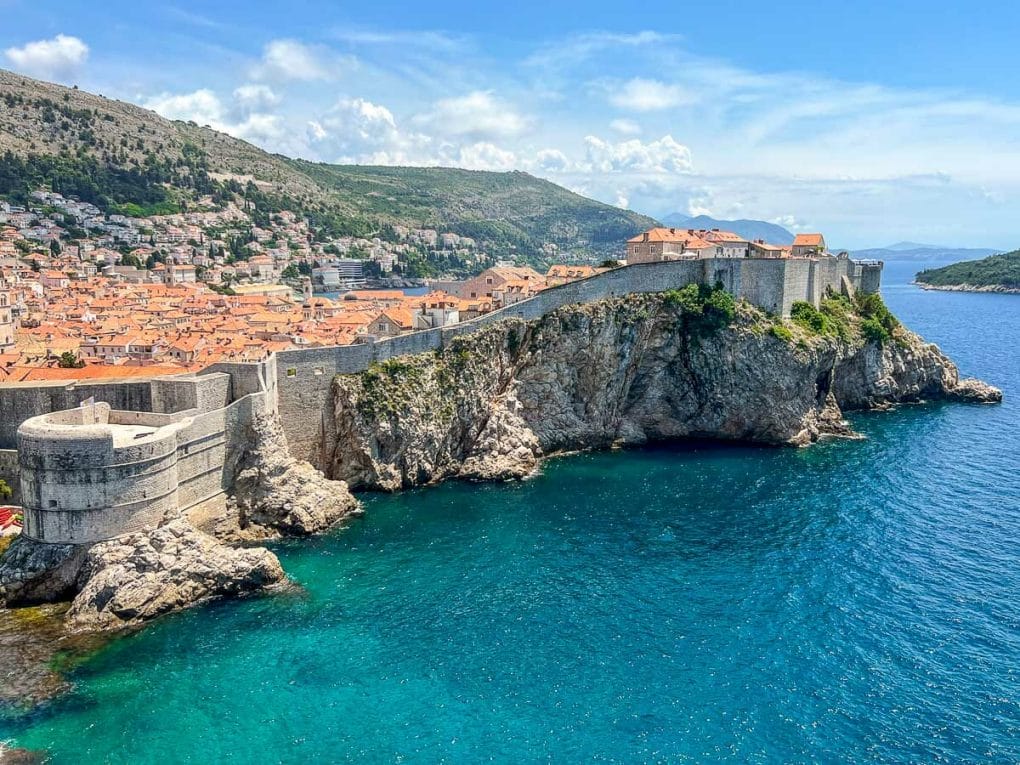
Is one week in Croatia enough time?
Yes, one week in Croatia provided a good amount of time to see what we wanted to see. We managed to fit five different destinations into our trip!
However, I think 10 days in Croatia would probably have been the absolute perfect amount of time if you can swing it, because we left without time to see more of Croatia’s best cities, islands, and day trips (like visiting Montenegro). But all in all, we had a great first visit in a week.
Best time to visit Croatia
The most popular time to visit Croatia is the summer, specifically July and August. According to many locals, this time of year also happens to be the busiest and the most crowded.
But if you can, visiting during shoulder season (spring and fall) may be even better as the city sees more affordable prices, fewer crowds, and still pretty fantastic warm weather.
We visited early June, which was beginning to feel crowded but was pleasantly sunny and pretty hot with average temperatures in the mid-80s (low 30s C).
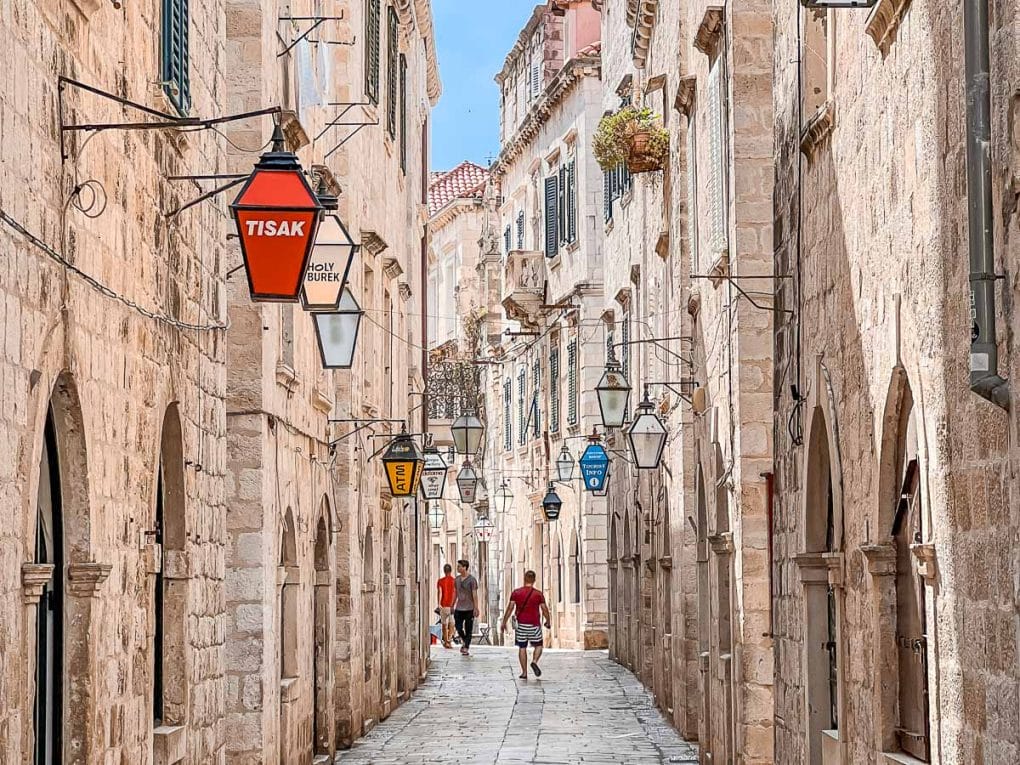
How to get around Croatia
When traveling and backpacking the Balkans and Croatia, you have a few options.
Croatia by bus
Croatia is very well connected nationally by buses, and it’s the cheapest option to get around. We found navigating the bus lines fairly easy between Zadar, Dubrovnik, Split, and even Plitvice Lakes.
I personally used the Flixbus app to purchase all our tickets, but it’s possible to use the website getbybus.com or to buy tickets at the bus station. Ticket prices ranged from $10-$15 per person per way.
We booked our buses a day or two in advance and never had an issue. If visiting during July and August, you may want to get your tickets at least a day before to ensure a spot.
Renting a car
Many people opt to rent a car in Croatia so they have ultimate freedom to visit smaller destinations. And since by bus is the other primary mode of transportation, having a car means faster transport from place to place.
Manual cars were running about €350 for the week versus automatics were €650 when I looked for June. If you can’t drive manual, you should book in advance as there are far fewer automatics available.
It’s also worth noting that many popular places like old town Split and Dubrovnik are car-free. If you’re staying in the heart of the old town, you’ll need to park outside of the walls and walk.
Trains in Croatia
Unlike the rest of Europe, it’s not possible to get everywhere via train in Croatia – especially along the coast. I believe the northern part of the country has train routes, and it’s possible to train to Split from Zagreb. However, the journey is long, clocking in at around 6 hours.
You can check Croatia’s train routes here.
Croatia by Cruise
Croatia is also a popular destination for cruises for those that enjoy the perks that sailing along a beautiful destination provide. You can take your pick from large cruise lines or luxury small ship cruises in Croatia.
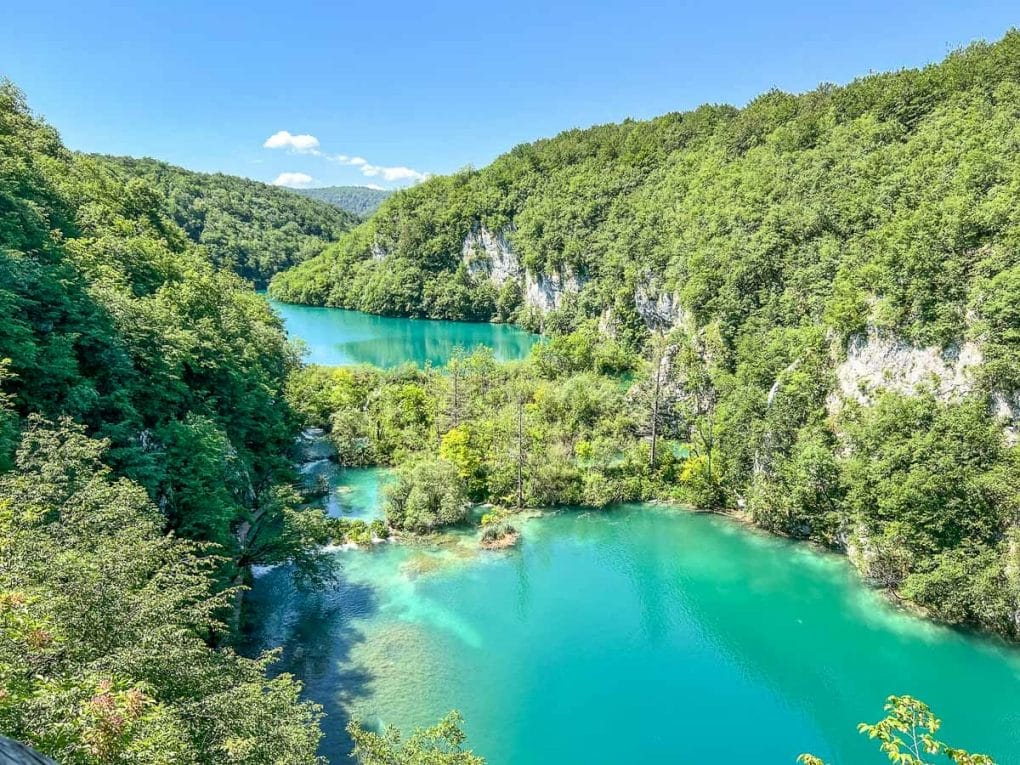
10 Best Places to Visit in Croatia
1. Dubrovnik
2. Split
3. Plitvice lakes National park
4. Hvar Island
5. Krka National Park
6. Pula
7. Zagreb
8. Istria
9. Zadar
10. Korcula Island
5 Different Ways to Spend 7 days in Croatia
There are a million ways to spend a week in Croatia, but here are some ideas for how to fill your time. These places listed are recommended main stops.
But from each destination, there are many smaller day trips worth taking to fill out your Croatia itinerary that I’ll cover next!
Classic Croatia: Zagreb – Plitvice Lakes – Split – Dubrovnik
Dalmatian coast: Zadar – Dubrovnik – Split – Plitvice Lakes
Nature lovers: Split’s Islands – Krka – Plitvice Lakes
Leisurely visit: Split – Dubrovnik
Day tripper: Full seven days in Split or Dubrovnik
When trying to decide how much time in each place, I recommend allocating less for Zadar and Zagreb (no more than a day), and more for Split and Dubrovnik (2-3+ days).
Krka and Plitvice Lakes can each be done in a day too.
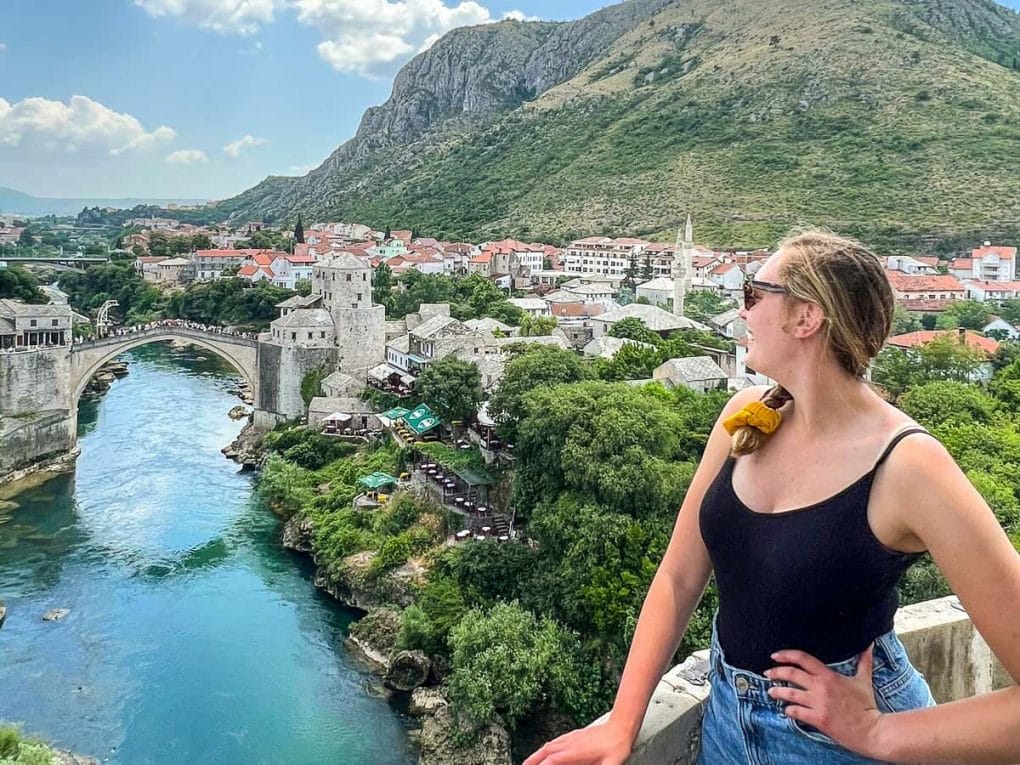
Popular Day Trips in Croatia
Croatia isn’t all that big, which means that it’s easy enough to visit rural attractions without it eating up too much time. Unfortunately, you still won’t have time for all of these beautiful places in Croatia.
But here are some of the most popular day trips in Croatia:
- [From Split] Island hopping tours, Blue Lagoon, Blue Cave
- [From Split] Hvar Island
- [From Split] Trogir
- [From Split, Zadar, Zagreb] Krka National Park
- [From Split, Zadar, Zagreb] Plitvice Lakes National Park
- [From Split, Zadar, Zagreb] Croatia’s other national parks: Kornati and Telascica
- [From Split, Dubrovnik] Mostar and Kravice Waterfalls, Bosnia
- [From Dubrovnik] Montenegro
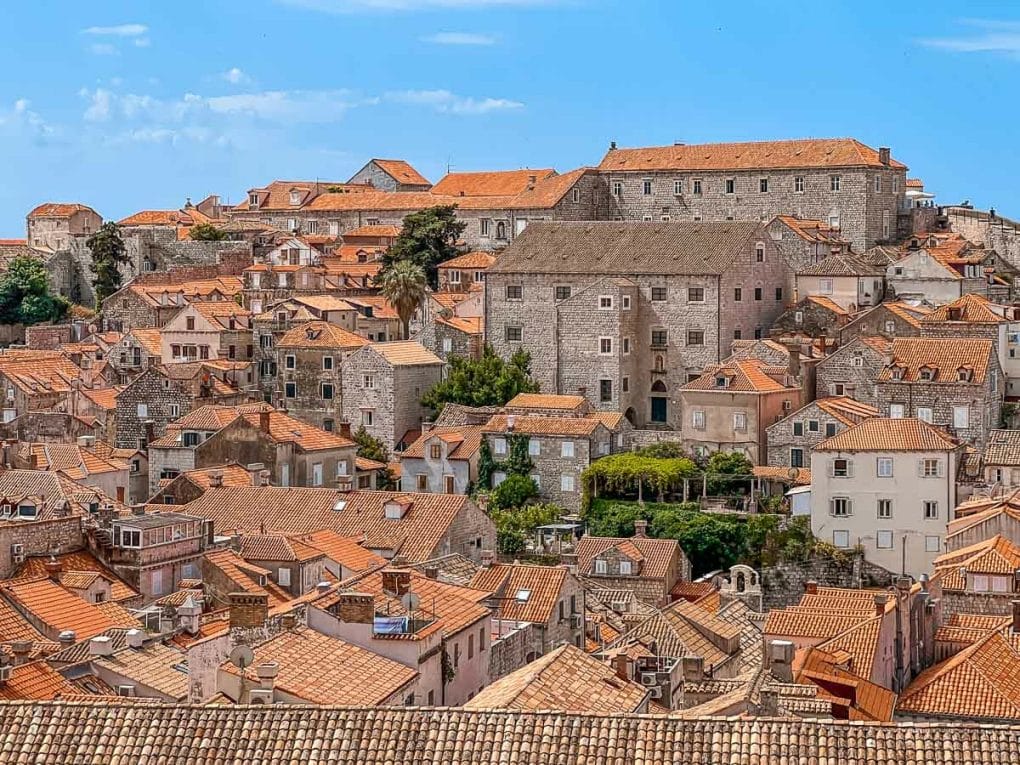
Our 7 day Croatia Itinerary: A Visit to Croatia’s Dalmatian Coast
Given where we live in Germany, our cheapest and most direct flight was to Zadar. We landed early in the morning and decided to make the long trek to Dubrovnik and make our way back to Zadar throughout the week.
We took Flix Buses in between each place and booked cute guest houses in the old towns of each city.
How to Spend 3 Days in Dubrovnik
We kicked off our visit with a long 8-hour bus ride from Zadar to Dubrovnik, which includes a unique border crossing into Bosnia for a stretch of 20 miles. The drive was long but honestly gorgeous as you follow the coast pretty much the entire way.
What is Dubrovnik known for?
Dubrovnik has become one of Croatia’s most popular destinations thanks to its well-preserved ancient history, oceanside locale, and unbelievable beauty. It’s recognized as a UNESCO World Heritage site and boasts intact city walls that date back to the 13th century.
You may also famously recognize the city from Game of Thrones, as it’s where many key scenes were filmed. GOT references dominate the entire city.
If there’s anywhere you visit in Croatia, it should be Dubrovnik. However, it was super touristy, grew crowded when cruise ships docked, and was by far the most expensive place we visited in Croatia. But I still highly recommend it!
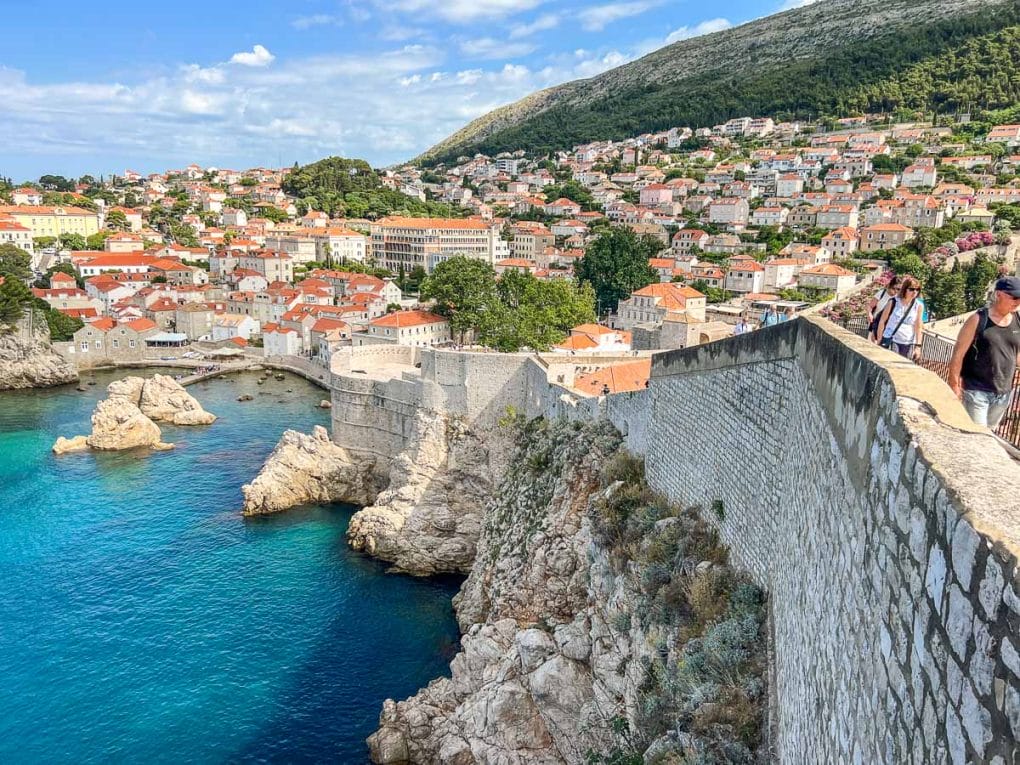
Where to Stay in Dubrovnik
I absolutely recommend staying in the heart of the old city during your visit to Dubrovnik if you can! However, you’ll need to book early enough to secure a room before they fill up.
Most of Dubrovnik’s accommodation options in the old city are guesthouses or private apartments. There are also fantastic luxury hotel options that dot the coast not far from the old town.
Recommended Dubrovnik accommodation:
- Guesthouse Rustico: We stayed at this cute, historic guesthouse inside the walls and enjoyed incredible views of the city and Fort Lovrijenac.
- Boutique Hotel Stari Grad: A 4-star hotel in the old city with fantastic views.
- Villa Orsula: Luxury accommodation is done well at this stunning Dubrovnik Hotel, located a few miles from the old town along the gorgeous coast.
- Old Town Hostel: Backpackers and solos should check out this hostel which rocks a perfect location, cheap dorm beds, and reasonable private rooms.
3 Day Dubrovnik Itinerary
Depending on your speed and style of travel, I recommend this Dubrovnik itinerary:
Day one: Old town attractions
Day two: Mostar day trip
Day three: Another day trip or tour (Sea kayaking, Montenegro, Krka, etc.)
You could skip the second day trip and enjoy another day in Dubrovnik, too. But honestly, all the main sights can be done pretty quickly.
Plus, most day trips finish by 6:30pm, giving you a few extra hours for evening exploration in Dubrovnik. And in the summer, the sun doesn’t set till 9:30pm.

12 Things to Do in Dubrovnik
Most of Dubrovnik’s attractions can be done pretty quickly, but you’ll need about two hours for the city walls and a few hours for the Game of Thrones tour (which is essentially a walking tour of the old town).
Here are some of the best things to do in Dubrovnik to fill out your itinerary:
- Walk Dubrovnik’s Old City Walls.
- Climb up to Fort Lovrijenac.
- Take the cable car or hike up Srd Hill and have a drink/lunch at Panorama.
- See filming locations on a Game of Thrones walking tour like the Jesuit Steps (Cersei’s shame walk) and Dubrovnik West Pier (Blackwater Bay).
- Sip beer and take a dip at one of a few cliffside bars like Buza Bar.
- See how royalty once lived at the Rector Palace.
- Check out the cathedral.
- Soak up some sunshine at the Plaža Banje beach.
- Treat yourself to fine dining and fresh seafood.
- Sample local wines with a tasting at D’Vino Wine Bar.
- Go on an adventure with a sea kayaking tour or zip-lining at the top of Srd Hill.
- Take a day trip to the beautiful Kravice waterfalls and Mostar in Bosnia or to the impressive Odysseus Cave on Mljet Island.
Where to Eat in Dubrovnik
We found eating out in Dubrovnik to be pretty expensive, and most options were either local fast food joints or fine dining. We spent a lot of $$$ on food, but it was delish.
Best restaurants in Dubrovnik:
- Domino Restaurant: traditional and gourmet Croatian dishes with a nice spacious terrace down a quiet side street.
- Oyster & Sushi Bar Bota: fresh seafood and unique oyster offerings.
- Gradska Kavana Arsenal Restaurant: upscale dining with terrace seating on the water. Reservations book up weeks in advance during the busy season.
- Barba: popular fried “fast” seafood spot with limited seating.
- Glam Bar: reasonable drafts and cocktails
- The Bar: unique cocktail concoctions
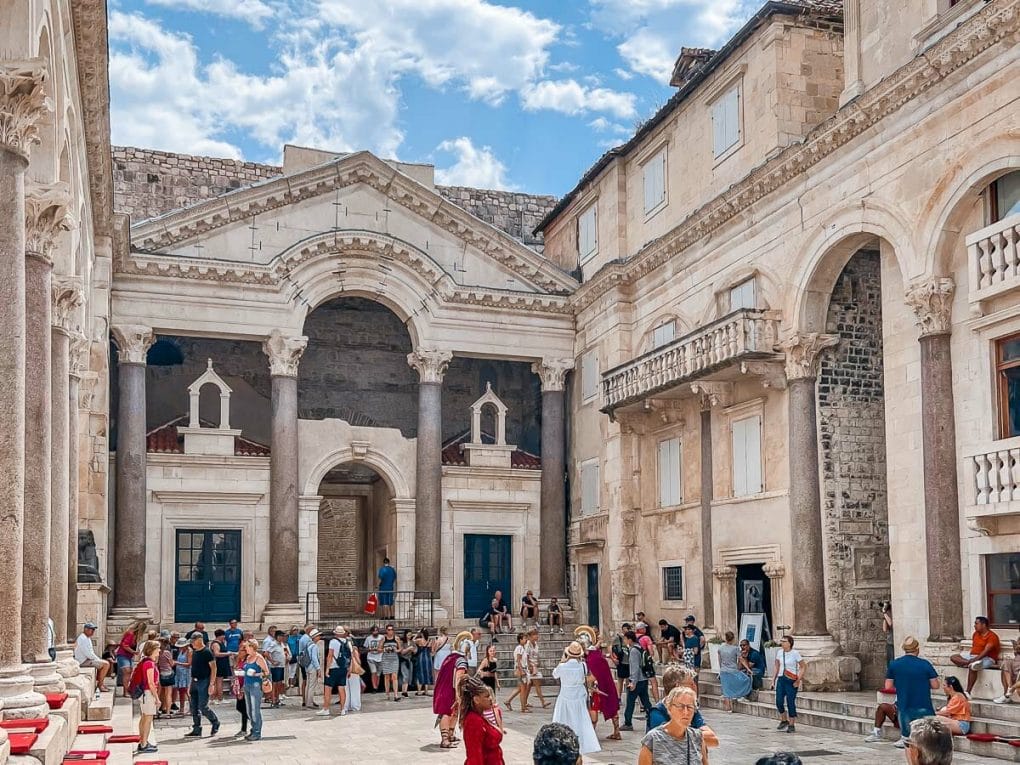
How to Spend 3 Days in Split
We actually spent more like 2.5 days in Split, taking the midday bus to Zadar on our last day. But for those with three days, this is how you can spend it.
What’s Split known for?
Split is Croatia’s second-largest city and is home to the incredible old city left behind by the Romans that occupied the area for centuries. Walking within the old city walls really felt like a mini Rome, where ruins and charming marble streets greeted you at almost every turn.
We found Split to be a lot more affordable compared to Dubrovnik, and the food scene was pretty fantastic. The city is located on a small peninsula along the Adriatic Sea about halfway between Dubrovnik and Zadar.

Where to Stay in Split
I recommend staying in the old town. It’s not only the best place to enjoy the Roman ruins but also near the harbor where most island tours leave from.
Noteworthy accommodations in Split:
- Apartments Salvezani: we stayed here and enjoyed this cozy little apartment with a kitchen in the heart of old town Split.
- Hotel Posh: a chic hotel outside the old town with a pool and ocean views.
- Sperone Heritage Hotel: beautiful historic hotel in the heart of downtown with a pool.
- Ćiri Biri Bela boutique hostel: stylish and cozy hostel with reasonable rates.
3 Day Split Itinerary
The newer part of Split is like any other city, which means the best area to explore (in my opinion) is the old city. However, the historic part of Split within the old walls is quite small, and you really only need a day in Split itself.
The rest of your time is better spent taking advantage of the beautiful destinations off the coast of Split and the surrounding areas.
Day 1: Old Town Split
Day 2: Hvar + Island Hopping Tour
Day 3: Day trip (Trogir, other islands) or chill at the city beach
Many people love Hvar, so you could even plan to spend a full day or half-day visiting just Hvar and another day island hopping to other places around Split as there are many charming little places to see.
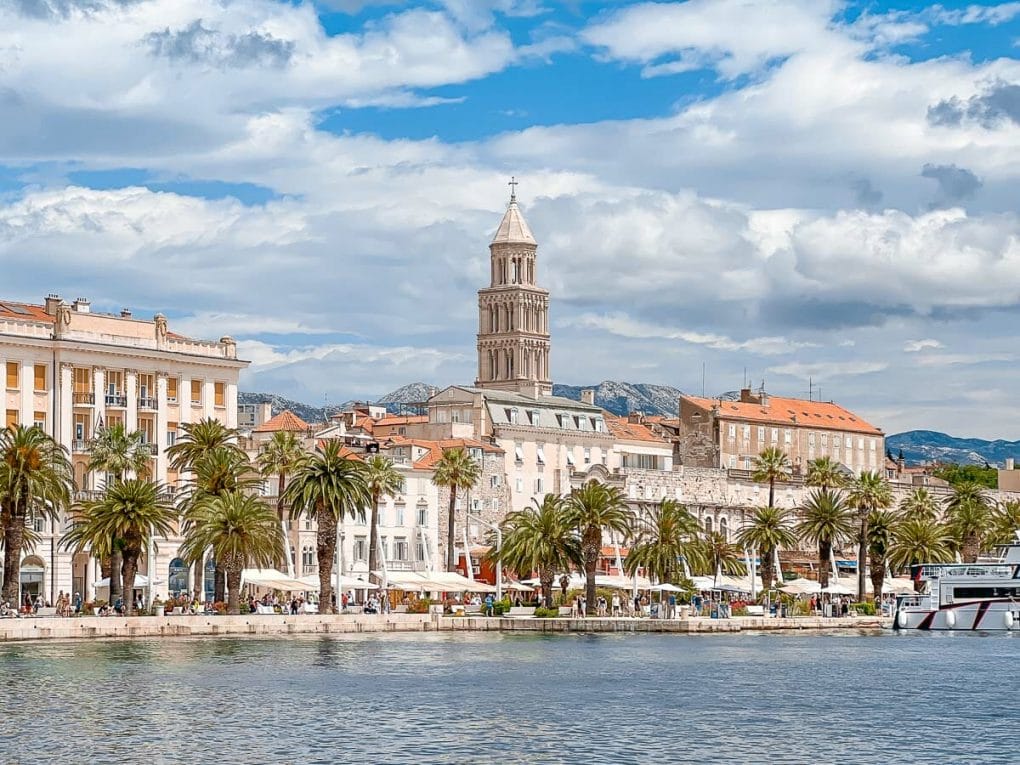
11 Best Things to Do in Split
We enjoyed our time in Split, but the city is another destination that’s easy to see in a day or two. But there are plenty of worthwhile day trips and tours to enjoy during your stay.
Best things to do in Split:
- Take a day trip to visit Hvar island and explore the streets of the old fishing village.
- Snorkel in the Blue Lagoon and pass through the Blue Cave on an island hopping tour.
- Marvel at Diocletian’s Palace, a Roman palace built in the 4th century.
- Pick up Split’s yellow ticket for entry to:
- Saint Domnius Cathedral, the world’s oldest cathedral
- The cathedral’s Bell Tower for panoramic views of Split.
- Jupiter Temple
- The old treasury located in the Ticket Office
- Stroll and shop Diocletian’s Cellars under the palace.
- Snap photos of the Vestibule.
- Get lost in the winding streets and squeeze through Split’s smallest street
- Walk along The Riva promenade, aka Oceanside walkway.
- Swim and tan at Bacvice Beach.
- Go shopping at the Mall of Split.
Unfortunately, our island hopping tour to Hvar, the Blue Cave and Blue Lagoon we had booked was canceled due to high winds and dangerous waves. So keep in mind this is a possibility.
However, our tour operator offered us a modified tour to Trogir, the Blue Lagoon and Šolta (a cute, small island village) and promptly refunded us the difference. I’m bummed we missed Hvar and the Blue Cave (two popular places near Split), but we still had a lovely half day.
Where to Eat in Split
We found restaurants in Split to be much more affordable than Dubrovnik, and equally as delicious.
Best restaurants in Split:
- Sladoledarnica Emiliana: creamy and delicious gelato made in the shop.
- Corto Maltese Freestyle food: popular spot with upscale food and cocktails that was pricey but one of our fave meals the whole trip.
- Bepa!: a cute brunch spot with terrace seating in one of Split’s main squares.
- Noor: modern and cool cocktail joint with limited seating.
- Pandora Greenbox: by the same people who run Corto, but their take on vegetarian food.
- Fig: a popular restaurant with stellar reviews that serves breakfast, lunch and dinner.

How to Spend ½ Day in Zadar
We spent two nights in Zadar, but only about half a day actually seeing the city. We took a day trip to Plitvice Lakes National Park our second day before flying home the next morning.
What’s Zadar known for?
Zadar can be found on the northernmost Dalmatian coast and is known as a quieter and smaller place to visit compared to Split (located about 1.5 hours to the south).
The city was also occupied by the Romans, who left behind beautiful landmarks worth seeing. As another coastal destination, there’s fresh seafood and beaches to enjoy too!
Zadar is also one of the most convenient places to visit Plitvice National Park if you’re only interested in doing a day trip versus a stayover. The lakes are 1.5 hours away.
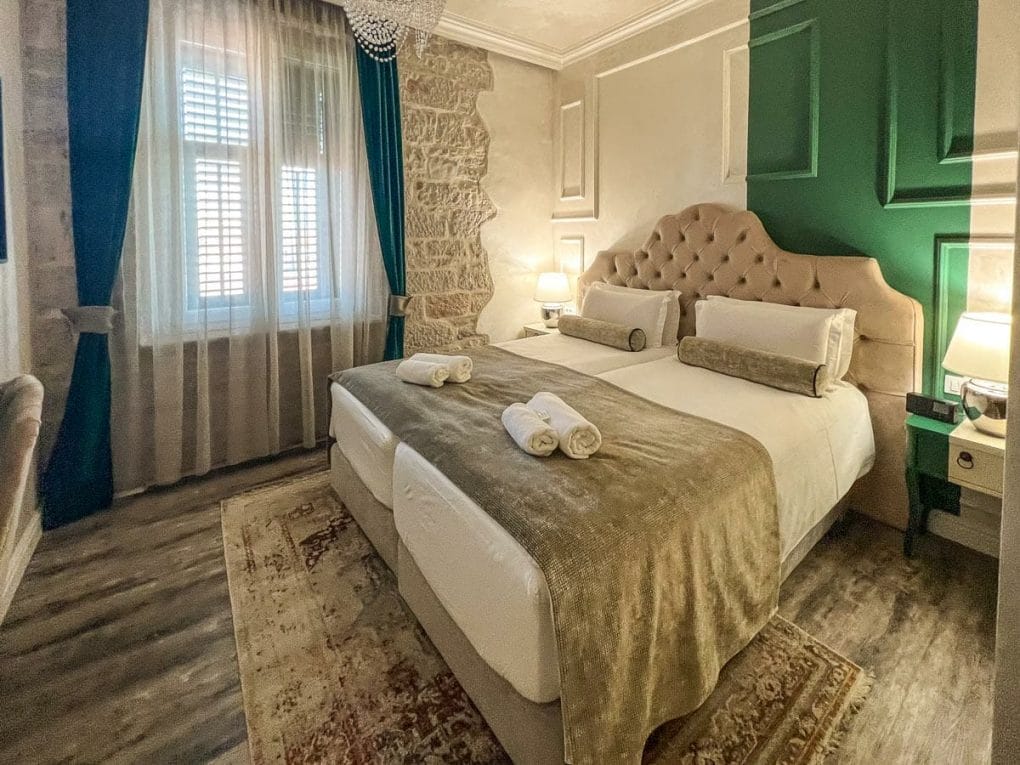
Where to Stay in Zadar
As with Dubrovnik and Split, I recommend staying in the old city to be close to the water and main attractions.
Cool Zadar accommodation:
- Riva Design Palace: this cute little hotel had great rates and was situated right outside of the old city walls in a historic hotel meets apartment building.
- Bastion Heritage Hotel: a luxury hotel with a spa and gourmet restaurant serving med dishes in the historic city center.
- DeZign Superior Apartments and Rooms: modern interior design and cozy guesthouse style accommodation make this a nice pick in Zadar.
- Downtown boutique Hostel: budget hotels don’t have to be low quality and this boutique hostel is my top pick for budget backpackers and solo travelers.

9 Things to Do in Zadar
As mentioned, you don’t need much time in Zadar. You can walk from end to end in the old city in less than 15 minutes. I recommend making time for the Roman ruins, climbing the belfry, and just enjoying the charm of the city.
If you have more than a half-day to spare (or aren’t fussed about seeing more Roman ruins)—Kornati National Park is nearby, noted for its small islands and bright blue waters. Otherwise, you could enjoy a beach day at one of Zadar’s beaches.
Here’s a more detailed list of what to do in Zadar:
- Spend the day at the beach: Maestrala Karma, and Kolovare Beach.
- Visit the city’s old Roman churches like the Church of St. Donatus, St. Chrysogonus and Simeon.
- Check out Zadar’s cathedral and climb the belfry for a bird’s eye view of the peninsula.
- Stroll the sea promenade and listen to the Sea Organ play a tune (a great spot for the sunset and a swim).
- Walk along the Roman forum where a local market makes for good souvenir shopping.
- Get lost in the city streets and see the old walls, the Land Gate, and the People’s Square.
- Get a history lesson at Zadar’s Art and Archeological Museum.
- Have a drink on Stomorica, a short strip of tiny bars.
- There are many worthwhile day trips from Zadar including nearby Kornati and Telascica national parks.
Where to Eat in Zadar
We didn’t have as much time to explore the food scene in Zadar, but we managed to find some cool spots!
Some of the best restaurants in Zadar:
- Tri Bunara: a cool pizza joint that also serves breakfast.
- Butler Gourmet&Cocktails Garden: traditional Croatian dishes with modern flair in a beautiful establishment.
- The Garden Lounge: open-air bar with cozy seating great for catching the subset.
- Foša: fine dining seafood restaurant with a three-course set menu.

DIY Day Trip to Plitvice Lakes National Park
Plitvice Lakes National Park, or Plitvička jezera in Croatian, is an impossibly beautiful natural wonder in the center of the country. The parks protect the turquoise waters of 16 lakes, 90 cascading waterfalls, and an immense stretch of verdant forest that span across a canyon—all of which visitors can see from rustic boardwalks.
How to Get to Plitvice Lakes National Park
By car
Driving to Plitvice Lakes is a popular option as many opt to explore Croatia by car. However, it’s important to mention that parking is limited and can fill up quickly during peak hours. Parking at the park is also not free, and costs about 8 HRK ($1.15) per hour for a car.
Here’s a rundown of drive times:
- Zagreb is just under two hours from Plitvice Lakes National Park.
- Zadar is about an hour and a half.
- Split is two and a half hours.
By bus
We decided to take the bus to Plitvice. It was a cheap and easy option, and we found the Flix Bus route from Zadar to the park to be comfortable.
The buses drop off at both the first and second entrances at unmarked wooden shelters. When you book tickets, the stop is actually called Plitvička Jezera, which is the name in Croatian.
A one-way ticket costs between €14-€23. The first buses arrive at the park around 10:00-11:00 am, with a few departures in the afternoon around 3:00, 4:00, 5:00, and 6:00pm, depending on where you’re going.
By private tour
Taking a private tour to Plitvice Lakes is a super convenient option that takes care of the hassle of transportation. Although the tours often visit during peak visiting hours, it can be worth it for those trying to optimize their time in Croatia.
There are private tours to Plitvice Lakes National park from Zagreb, Split, and Zadar.
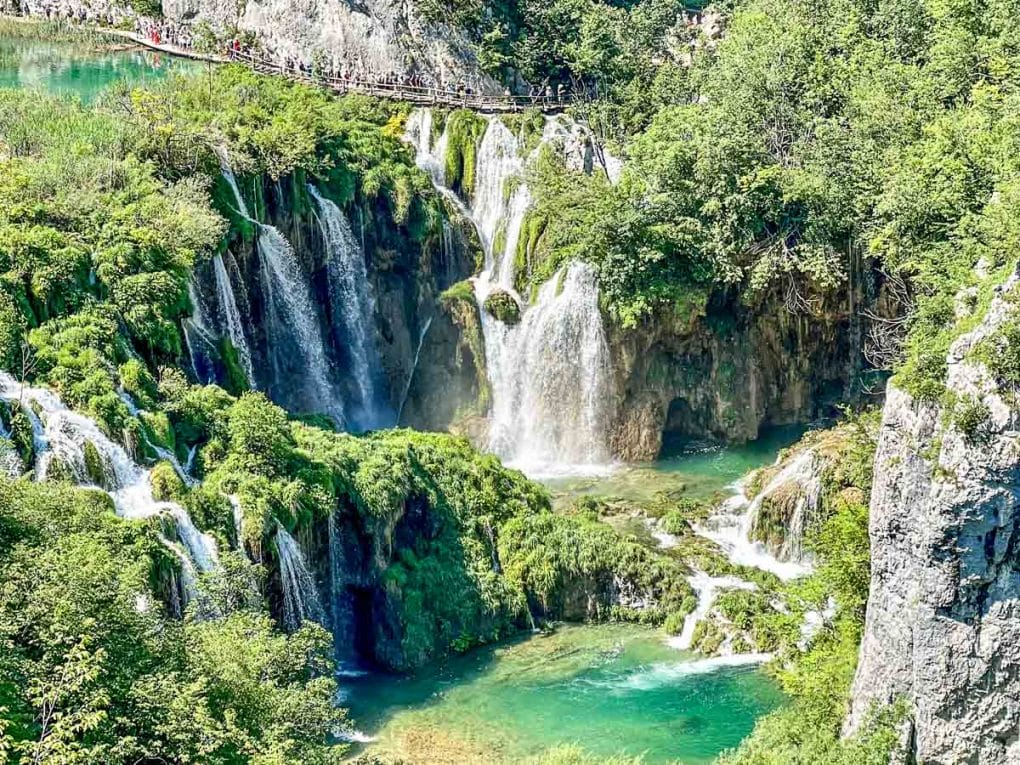
Things to Know When Visiting Plitvice Lakes
Before you visit the park, here are some Plitvice Lake tips I wish I’d known in advance:
- Buy your ticket online in advance at least one day before. You can’t buy it online the day of.
- If buying the day of, you can see ticket availability per entrance, per hour time slot in advance and you can pay with cash or card. But I don’t recommend buying the day of during peak season of July and August.
- Hold onto your ticket during your visit, you may need to scan it for boat rides and shuttles.
- Route A and B takes you along the lower lakes, and is the busiest part of the park.
- Most people visit mid-morning around 10 am, so to avoid crowds it’s best to visit right at open or mid-afternoon.
- The classic view of the boardwalks from above is near the end of Route C.
- You can’t swim in the park so there’s no need for a swimming suit.
- There are a few bathrooms and cafes along the trails, specifically at the entrances and boat and shuttle stops.
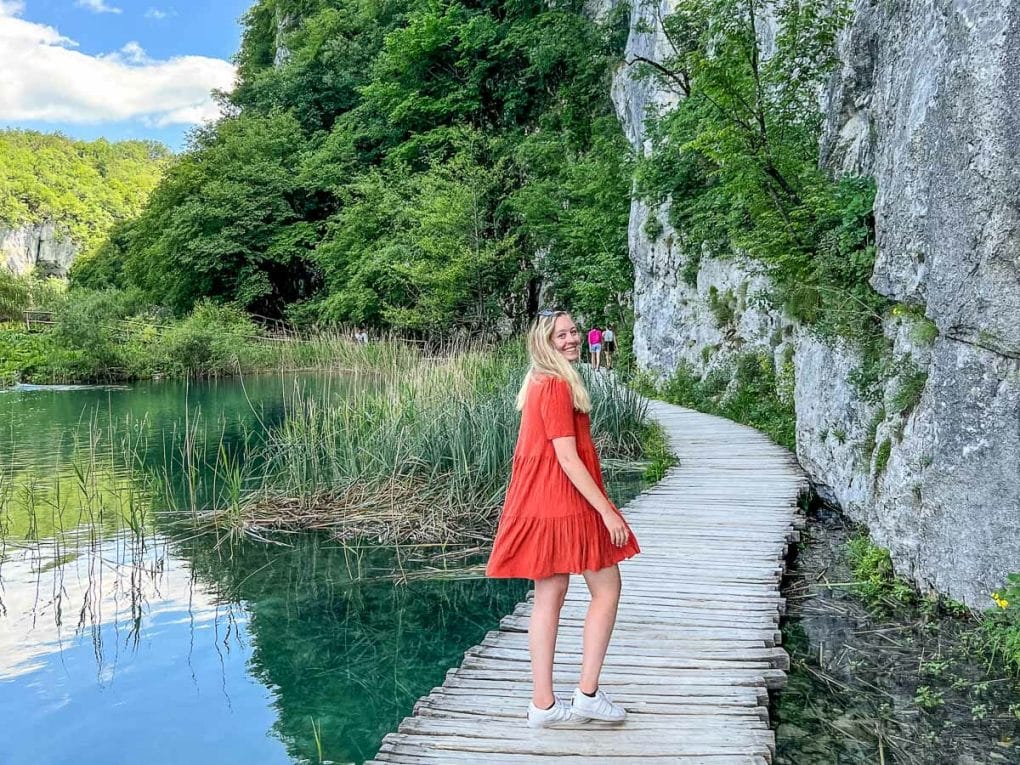
What is Plitvice Lakes known for?
The National park is one of the most beautiful places in all of Croatia thanks to the many lakes, waterfalls, and surrounding lush greenery. The park is made up of a network of boardwalks that take you along it all – it’s truly a sight to see.
Other people have done a fantastic job breaking down the details of how to visit Plitvice Lakes, so I’ll simply share their guides that I found super helpful.
Thanks to the recommendations of TripTins and One Chel of an Adventure, we decided to do Route C from entrance 1 which covered both the lower and upper lakes.
It took us about 4.5 hours to complete it, including photo breaks and a quick lunch at the shuttle stop. But we were moving fairly quickly.
Where to Stay Near Plitvice Lakes
If you decide to spend the night instead of doing a day trip, here are some cozy places we were considering ourselves.
- Pansion Breza a charming family-run guesthouse in a quiet location right by the park.
- Hotel Plitvice a seasonal hotel with prime views of the Plitvice Lakes.
- Hotel Jezero another Plitvice Lakes hotel in the heart of the park that’s open year-round.

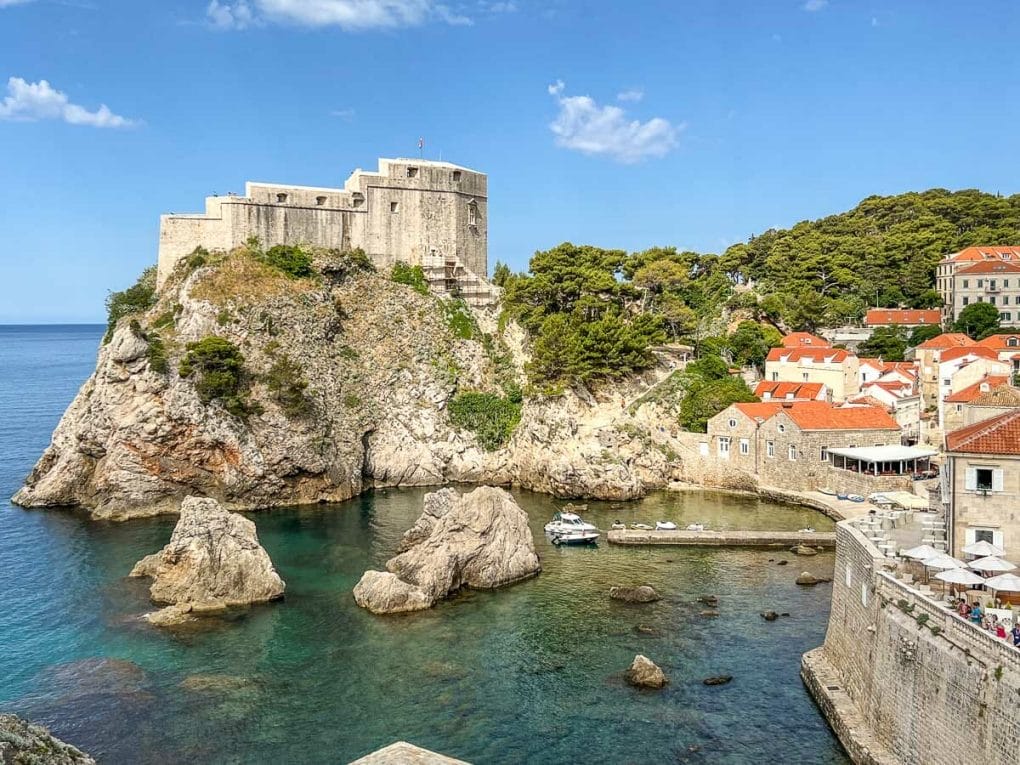
Thanks again, Brit, for such a thorough guide!